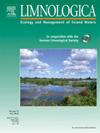Interannual variability in dissolved organic matter (DOM) concentration and quality in shallow water bodies of Tierra del Fuego (Argentina)
IF 2
4区 环境科学与生态学
Q2 LIMNOLOGY
引用次数: 0
Abstract
Dissolved organic matter (DOM) is a crucial component of the global carbon cycle, significantly influencing aquatic ecosystems through its quantity and quality, which are shaped by abiotic factors such as precipitation, runoff, and solar radiation. Recently, the role of winter conditions, particularly ice cover, has gained attention due to the ongoing biogeochemical processes that occur during this period. This study explores the effect of winter precipitations on DOM dynamics in humic shallow lakes and beaver ponds in Tierra del Fuego over two consecutive years. Higher accumulated precipitation in 2021 compared to 2022 led to differences in DOM properties. While dissolved organic carbon (DOC) levels were higher in 2022, likely due to concentration effects from reduced precipitation, shallow lakes and beaver ponds exhibited distinct responses. Absorbance-based (water color, SUVA and spectral slope) assessments revealed a slight increase in DOM molecular size in shallow lakes during 2022, whereas fluorescence-based indices (HIX and BIX) indicated greater humification in 2021 but fewer humic components, suggesting complex patterns of allochthonous DOM mobilization. These findings highlight the importance of precipitation regimes and runoff in shaping DOM dynamics in subantarctic aquatic systems, with significant contribution from the surrounding soils and vegetation.
阿根廷火地岛浅水水体溶解有机质(DOM)浓度和质量的年际变化
溶解有机质(DOM)是全球碳循环的重要组成部分,通过其数量和质量对水生生态系统产生重要影响,而其数量和质量受降水、径流和太阳辐射等非生物因素的影响。最近,由于在此期间发生的持续生物地球化学过程,冬季条件,特别是冰盖的作用引起了人们的关注。研究了连续两年冬季降水对火地岛腐殖质浅湖和海狸池DOM动态的影响。与2022年相比,2021年的累积降水量更高,导致DOM特性的差异。虽然溶解有机碳(DOC)水平在2022年较高,可能是由于降水减少的浓度效应,但浅湖和海狸池塘表现出明显的响应。基于吸光度(水色、SUVA和光谱斜率)的评估显示,2022年浅湖DOM分子大小略有增加,而基于荧光的指数(HIX和BIX)显示,2021年腐殖质化程度更高,但腐殖质成分更少,表明异源DOM动员的复杂模式。这些发现强调了降水制度和径流在塑造亚南极水生系统DOM动态方面的重要性,其中周围土壤和植被的贡献很大。
本文章由计算机程序翻译,如有差异,请以英文原文为准。
求助全文
约1分钟内获得全文
求助全文
来源期刊

Limnologica
环境科学-湖沼学
CiteScore
3.70
自引率
5.90%
发文量
64
审稿时长
3 months
期刊介绍:
Limnologica is a primary journal for limnologists, aquatic ecologists, freshwater biologists, restoration ecologists and ecotoxicologists working with freshwater habitats.
 求助内容:
求助内容: 应助结果提醒方式:
应助结果提醒方式:


